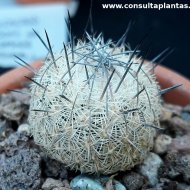Care of the cacti Echinomastus mariposensis or Lloyd's fishhook cactus |
|
The genus Echinomastus, family Cactaceae, includes about 10 species of cacti native to the southwestern United States and northern Mexico. Some species are: Echinomastus mariposensis, Echinomastus johnsonii, Echinomastus intertextus, Echinomastus unguispinus. Common names: Lloyd's fishhook cactus, Mariposa cactus, Golfball cactus, Silver column cactus, Lloyd's Mariposa Cactus, Mariposa Viszagita, Lloyd's Mariposa. This species is native to Coahuila (Mexico) and Texas (USA). They are small solitary cacti with bluish-green epidermis that reach 15 cm (5.9") in height. They have up to 21 ribs with narrow, pointed tubercles. The areoles have 23-26 whitish radial spines and 2-4 central erect spines, also white (they darken with age). The flowers, pink, white or purple, appear at the apex of the plant. They bloom in late winter. Due to their small size Mariposa cactus is used in pots on balconies and windowsills and as indoor and greenhouse plants. Echinomastus mariposensis needs full sun exposure and good ventilation if grown indoors. It resists frost well if the soil is completely dry. The soil can be a commercial substrate for cacti with 20% coarse sand; it is important that it contains little organic matter. Transplant every 3 years to renew the substrate. Always water moderately, waiting for the substrate to dry completely. Do not water in winter. Fertilize once in spring with a mineral fertilizer for cacti. Lloyd's fishhook cactus does not need pruning. Echinomastus mariposensis is a plant that are sensitive to the accumulation of water in the roots and to the attack of mealybugs and red spider mites if ventilation is poor. Golfball cactus is propagated from seeds sown in spring in a seedbed avoiding direct sun. |
Images of the cacti Echinomastus mariposensis or Lloyd's fishhook cactus |
Find plants
Echinomastus mariposensis or Lloyd's fishhook cactus | Care and Growing
© 2026 FavThemes
